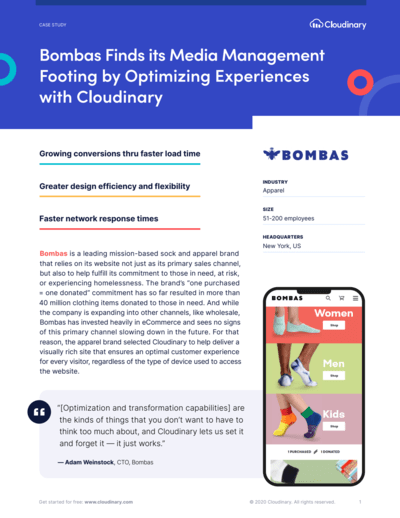Founded in 2013, Bombas is a leading apparel brand whose website serves as a primary sales channel and a conduit for fulfilling its mission to help destitute, at-risk, and homeless people. With comfort as a key attribute for its products, Bombas is dedicated to donating them to those in need. For example, shortly after launching the company, Bombas’s founders learned that socks were the most popular item at homeless shelters and spearheaded the mantra of “one purchased = one donated,” donating a pair of socks for every pair sold. Also, Bombas introduced “the most comfortable T-shirt” with the same donation match last year. So far, the company has given away more than 40 million pairs of socks and T-shirts.
On the business side, Bombas is investing heavily in wholesale and e-commerce, having selected the Cloudinary platform on which to redesign the Bombas site for an optimal user experience that works equally well in all viewing devices—known as responsive delivery.
This post describes the ways in which Cloudinary proved to be effective in meeting the needs and goals of the Bombas site and the vision of Bombas’s management for creatively leveraging Cloudinary’s robust capabilities in the future.
Media management was an immediate challenge for the goal of responsive delivery at Bombas, whose website boasted a high volume of 10,000 images. Other roadblocks abounded:
- Editing on Photoshop the various facets of media assets, such as the aspect ratio, colors, and background, which varied according to the context, was painstaking and time consuming.
- An upcoming rebranding initiative posed the uncertainty of whether the site’s background-color schemes would need to change once redesign was complete. Such an across-the-board shift would be costly and labor intensive.
- Meeting the deadline before the onset of the year-end holiday season meant not only a tight cycle, but also the unsettling probability that the redesign might lead to unexpected issues in user experience and cause holiday sales to suffer.
Nonetheless, an engaging, high-performant user experience was nonnegotiable. Yet how to pull that off in a timely manner?
Around October, Bombas replaced its content delivery network (CDN) with media-management platform Cloudinary for its optimization, transformation, and delivery capabilities, many of which are automated and all of which applied on the Bombas site. CTO Adam Weinstock couldn’t be more impressed with the result, “We found that when we put images on Cloudinary, we were able to optimize them easily with the benefit of Cloudinary’s underlying algorithms. [Optimization and transformation] are the kinds of things that you don’t want to have to think too much about, and Cloudinary lets us set it and forget it—it just works.”
In addition, Weinstock was impressed that, with Cloudinary, the Bombas site morphed into a truly responsive one without costly or burdensome overheads. Besides, Cloudinary’s cropping, resizing, and other image-editing features rendered the site sharp and pleasing, loading fast and working well on all devices. As for rebranding’s change-prone requirements for background colors, Bombas simply uploaded images with transparent backgrounds, whose colors Bombas could easily apply or change as necessary through Cloudinary.
Steven Kilzer, Bombas’s lead product designer, points out a big gain: “With Cloudinary, we set ourselves up for the future, ensuring that we could upload images—especially model shots that bleed off what the end-users actually see—[and] then change aspect ratios and image sizes on the fly. There’s now a lot of flexibility that was not possible with our previous manual processes.”
The integration with Cloudinary and subsequent implementation took only a few weeks. In the meanwhile, Bombas went into SWAT mode, vigilantly testing for performance and suggesting enhancements. “If we could shave off 100 milliseconds here or there, that would mean a solid user experience for customers with a huge impact on our overall conversion and repeat rates,” Weinstock said. “With Cloudinary, we were able to greatly reduce our page-load times. We got through Black Friday and Cyber Monday very successfully and have continued to grow the business.”
Kilzer had a thumbs-up for Cloudinary’s automated capabilities that cater well to ever-evolving image designs: “Just being able to use the same image in different ways—rather than having to manually crop it for a product-detail or product-listing page—has saved us a lot of time.”
Furthermore, Bombas could now dig deep and test the effect of image treatments, such as tight crops, enlargement, and wider views, on performance and visitor conversions. “Doing all that before would have taken too much time and effort,” Kilzer said, citing Cloudinary’s reliability as a major factor for efficient workflow and a compelling user experience. Besides, the Bombas team can now focus on tasks that demand human intelligence and creativity and on advanced projects that could take further advantage of Cloudinary’s offerings. The future is bright and promising.

